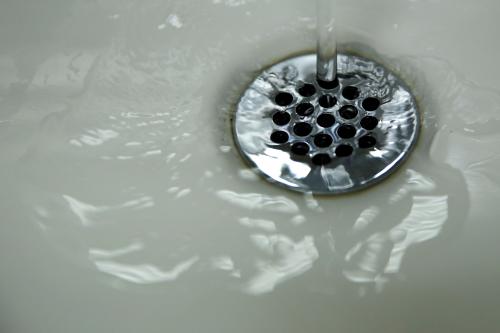This post was most recently updated on November 30, 2023.
Removing lead from America’s drinking water is gathering political support. The 2021 bipartisan infrastructure bill included $15 billion over five years to replace lead pipes and service lines across the United States. Although this figure was whittled down from President Biden’s original proposal of $45 billion, the effort is the federal government’s most ambitious on this front to date—and research suggests that the public health and economic benefits of doing so are extensive. In November 2023, the Environmental Protection Agency proposed regulatory changes aimed at removing all lead water pipes within 10 years.
What harm does lead do?
When a person swallows or breathes in lead particles, the body stores the toxin in the blood, bones, and tissues, where it accumulates over time. According to the Centers for Disease Control, there is no safe level of lead exposure. Lead is particularly harmful to children, causing reduced IQ, language development, and attention span, and increased aggression and impulsivity. In addition, prolonged exposure for both children and adults can damage the brain and nervous system, reduce fertility, and increase the risk of high blood pressure, heart disease, kidney disease, and likely even cancer.
What are the economic consequences of exposure to lead?
Lead’s effects on health have serious economic consequences for those exposed. A study of Swedish students found that an increase in blood lead levels from 5 to 10 micrograms per deciliter is associated with a decrease in 9th grade GPA of 2.2 percentile points, and a 2.3% decrease in the likelihood of graduating high school—academic consequences that imply a 5.5% decrease in average earnings in young adulthood.
There is also significant evidence that exposure to lead affects crime rates. A 1% increase in blood lead level has been shown to raise the probability of teenage aggressive behavior by 4% and criminal behavior by 5%, and for violent crimes, the associated increase is as large as 8%. Research suggests that phasing out leaded gasoline in the 1980s led to a significant decline in the number of violent crimes in the 1990s.
Disparities in lead exposure also exacerbate social inequities. According to a recent study in JAMA Pediatrics, children in high-poverty areas are nearly 2.5 times as likely to have elevated blood lead levels than children in low-poverty areas, and children in predominantly Black zip codes are about 9 percentage points more likely than children in predominantly white zip codes to have detectable lead in their blood. Due to racial disparities in lead exposure, Black infants are estimated to experience around a 50% higher average loss of IQ points attributable to blood lead than white or Hispanic infants, and an estimated $47,000 loss in lifetime earnings, compared to white and Hispanic losses of around $30,000. Furthermore, a number of studies have found that a given increase in blood lead levels can have larger effects on cognition, academic performance, and earnings for disadvantaged students than for their peers.
What has the government done to reduce lead exposure?
As a result of federal laws and regulations, including the 1973 phase out of lead in automobile gasoline, the 1978 ban on lead paint for residential and consumer use, the 1991 Lead and Copper Rule, and the 1995 ban on lead in solder in food cans, the median lead concentration in the blood of children aged 1 to 5 years dropped from 15 micrograms per deciliter in 1976-1980 to 0.7 micrograms per deciliter in 2013-2014. The JAMA Pediatrics study, however, found that half of 1.1 million American children under 6 tested positive for lead in their blood. Despite some progress in reducing the number of homes served by lead pipes, however, lead in drinking water remains an unresolved problem.
How prevalent are lead pipes and service lines?
Lead gets into drinking water via lead pipes, fixtures, and faucets as they corrode. The federal government banned the use of leaded pipe and solder in new plumbing systems in 1986, but many remaining pipe networks in older cities and homes predate the policy; the EPA estimates there are still 6 to 10 million lead service lines across the country. As of 2016, about 7% of households served by U.S. community water systems were estimated to have lead service lines, and the Biden administration estimates that around 400,000 schools and childcare facilities are currently exposed.
If we know lead is a public health hazard, why haven’t we gotten rid of all lead in the water yet?
Poor record-keeping, for one. Until recently, states and counties were not required to report blood lead testing data to the CDC (and most didn’t do so voluntarily), making it hard to determine high-risk locations or raise public awareness. Many cities lack comprehensive maps of where lead service lines are located. It was only in December 2020 that the federal government revised the EPA’s Lead and Copper Rule to require water utilities to create a public inventory of lead service lines, alongside other testing requirements that trigger reviews and payment assistance programs for replacement when high exposure levels are found.
Money is another big obstacle. Getting lead out of the water is time and cost intensive, with limited political will to do so. Individual households can buy water treatment filters to reduce lead levels at the faucet—Newark, NJ and Flint, MI have provided them free to residents in response to water contamination crises—but these filters need to be replaced relatively regularly and are less effective at high lead concentrations. The only permanent and 100% effective solution is a full lead service line replacement, which can be expensive—the EPA estimates an average cost of $4,700, ranging from $1,200 to $12,300 per line.
Lead service lines often extend onto private property, complicating the replacement process. Public water systems typically cover the cost of replacing the portion of the line extending from the water main to the curb stop or meter, but the property owner usually must pay to replace the segment of the line that goes to the home. In lower income neighborhoods, where the risks of lead exposure are high, the cost to customers of replacing privately-owned pipes may be prohibitive. Replacing only the utility-owned pipes is less cost-effective and can even increase the levels of lead in the water.
State and local governments have attempted to help property owners and utilities replace lines by offering grants and forgivable loans for pipe replacement, as well as by loosening restrictions to allow water utilities to raise rates to fund improvements to private portions of service lines. States and municipalities can also apply for federal funding to assist with water infrastructure projects addressing lead, but haven’t faced significant federal pressure to locate and remove 100% of pipes.
Some cities have tackled the problem—Madison, WI successfully ripped out all lead service lines in the city in 2001, after 10% of city water samples showed high lead concentrations. However, the city received significant pushback from homeowners (6,000 of whom faced an additional $1,300 plumbing bill), and it took years to get approval for the initiative from regulators and lawmakers. Removing 8,000 pipes took 11 years and cost $15.5 million.
Newark, NJ may be a model for a smoother replacement process. The city has replaced nearly all 18,500 lead service lines in the city in just over two years, at no cost to residents. The city cites several reasons for its success, including working with the state legislature to allow public funds for use on private property to replace lead service lines, a $120 million bond to fund much of the cost, and a city ordinance allowing them to replace lines on private property without homeowners’ permission.
How much would it cost to get lead out of the U.S.’s drinking water?
A back-of-the-envelope calculation based on EPA’s estimate of average replacement cost per line ($4,700) and assumption of 6 to 10 million lead service lines across the country suggests the cost could range from $28 billion to $47 billion, putting Biden’s originally-proposed $45 billion near the top of that range—but the $15 billion legislated well below it.
Research suggests it is an investment worth making. A 1987 EPA cost-benefit analysis of reducing the amount of lead permitted in drinking water by 60% found that the benefits of reduced exposure—including avoided medical expenses, lower compensatory education costs, and increased lifetime earnings—outweighed the costs of the policy by about 4 to 1, even without accounting for a number of health benefits that were difficult for the EPA to monetize. A 2019 Minnesota cost-benefit analysis of removing lead from all drinking water in the state estimated the costs would range from $1.5 billion to $4.1 billion over 20 years, and the benefits—including “mental acuity and IQ” improvements and the “resulting increases in lifetime productivity, earnings and taxes paid”—would range from $4.2 billion to $8.5 billion. The Environmental Defense Fund estimates that each full lead service line replaced would yield $22,000 in societal benefits from reduced mortality from cardiovascular disease alone, or (by their calculation) a return of over $3 per dollar invested.
What are the prospects for action?
The bipartisan infrastructure bill may not include enough funding to fully eliminate lead from drinking water in the United States but does provide unprecedented support to states (half in the form of grants and half as loans) to kickstart the process. The White House says it has approved $1.2 billion from that law—the first year of the five-year program—to identify and replace lead service lines and replace them in 23 states. The administration also is using other sources of funds and its regulatory apparatus to accelerate efforts to get lead out of the nation’s drinking water.
The EPA regulations put out for public comment in November 2023 are aimed at requiring all water utilities to replace lead pipes over the next 10 years. Among the changes, the EPA proposes to lower the threshold, from 15 µg/L of lead to 10 µg/L, at which utilities are required to inform the public and take action to reduce lead that leaches into drinking water.
Further information about upcoming lead pipe replacement funding can be found in the White House Office of Management and Budget’s Lead Pipe Replacement Funding Inventory, a part of the FY 2023 President’s Budget. The inventory tracks both enacted and appropriated funds by agency, program, and eligible recipients. For a summary of recent actions to reduce lead poisoning, see this November 2023 White House fact sheet.
The Brookings Institution is financed through the support of a diverse array of foundations, corporations, governments, individuals, as well as an endowment. A list of donors can be found in our annual reports published online here. The findings, interpretations, and conclusions in this report are solely those of its author(s) and are not influenced by any donation.






Commentary
What would it cost to replace all the nation’s lead water pipes?
May 13, 2021